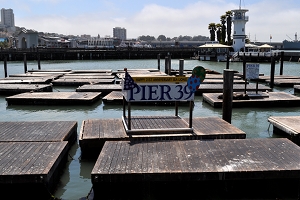 San Francisco's Pier 39 is home to only a few sea lions this summer.
San Francisco's Pier 39 is home to only a few sea lions this summer.
I spent Saturday sightseeing in San Francisco with a friend visiting from out of town, and I thought I’d check in on the sea lions at Pier 39. Just a few years ago, there were about 1600 of them, slithering on and off the wooden docks, basking in the sun, and barking at one another. Then in 2009, most of them swam away, as QUEST blogger Amy Gotliffe explained. The sea lions’ favorite food, herring, was in short supply, so they went to Oregon to feast on anchovies and salmon. Now the herring are making a comeback—will the sea lions return too?
This weekend the floating wooden palates at Pier 39 were mostly bare; there were perhaps a dozen sea lions. We would expect the sea lion numbers to be low this time of year, herring or no herring. In the summer, sea lions travel down south (the Channel Islands, San Diego, Baja) to breed. But there were still fewer sea lions at Pier 39 than in summers past.
Sea lions will eat a lot of different prey items: octopus, squid, small sharks. But their bread and butter is herring, which have been hard to find in recent years. The herring fishery is the only fishery still in operation in San Francisco Bay, and it closed during the 2009/2010 season (December through April), because there were so few fish. This year, the herring fishery opened again, but with a lower quota than in the past, to allow the fish to recover.
